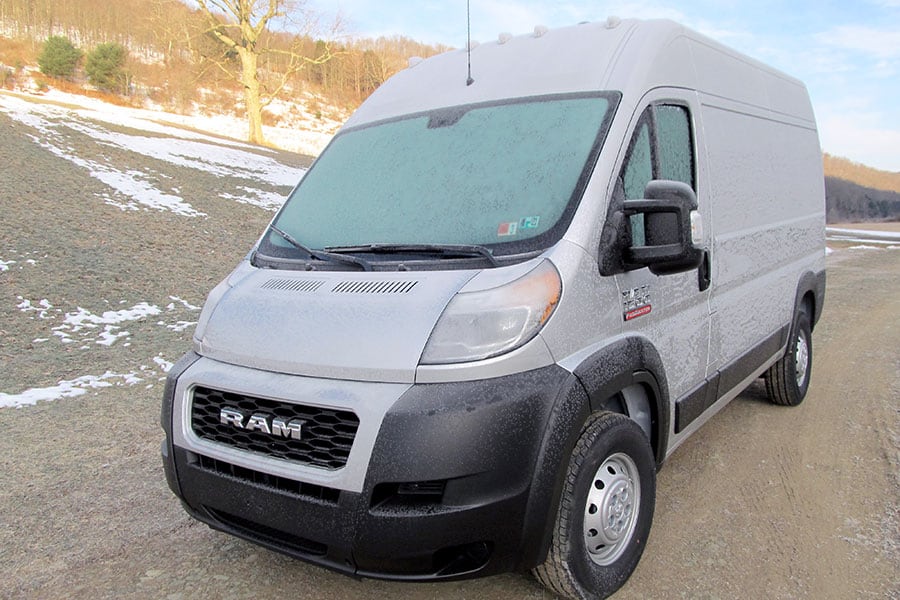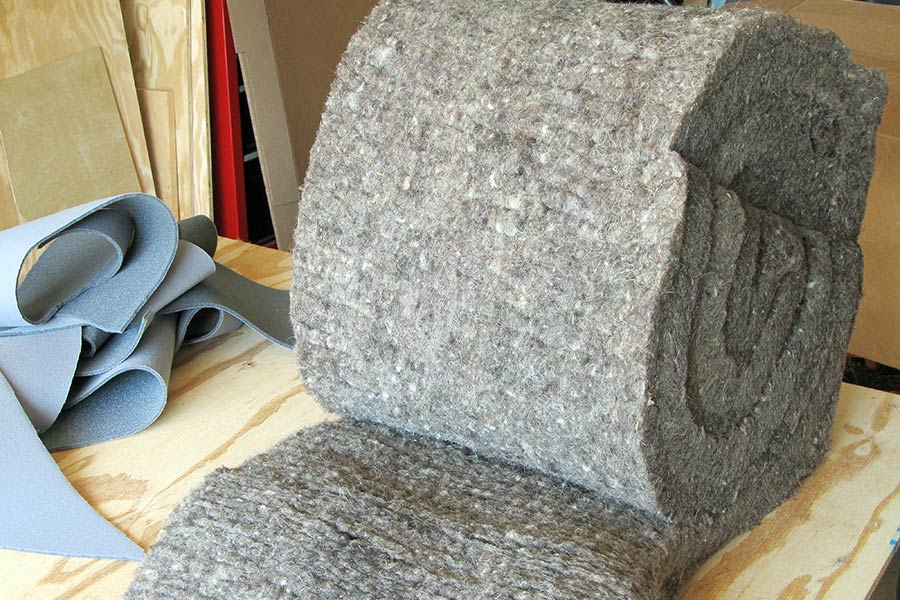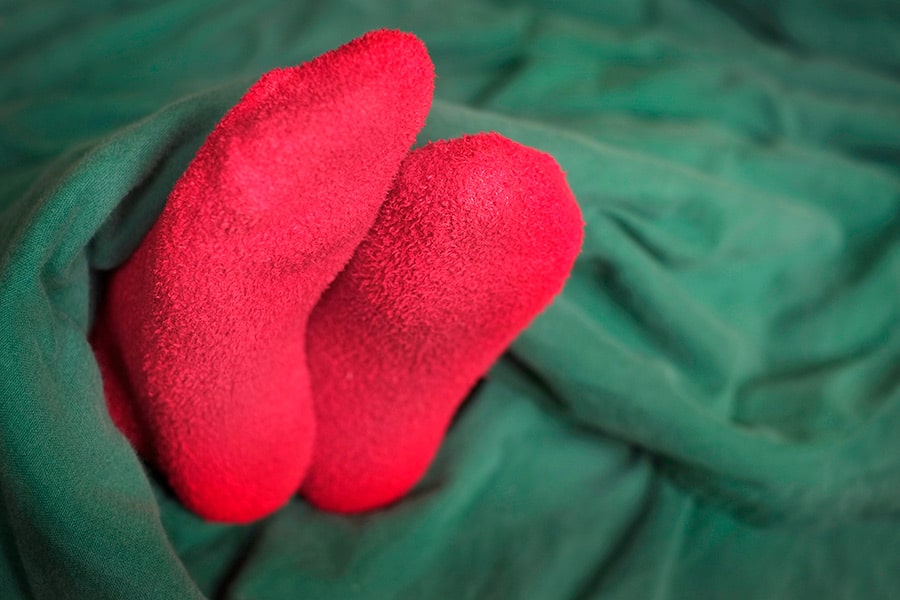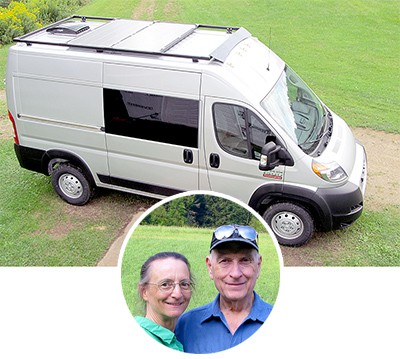
Cold weather might be a bit of a problem if you’ve never slept in a van before. You have to plan for it from every angle; otherwise, you’re bound to run into trouble. Believe me, there is nothing that you will hate more than waking up in the middle of the night freezing because you didn’t prepare properly.
If you want suggestions on how to stay warm sleeping in a van, then you’re in luck. You can keep the cold away with good insulation, the right type of clothing, and a few heating tricks to make your van feel cozy throughout the night.
Here are some of the tips you’ll learn about throughout this post:
- Proper insulation suggestions
- When and how long to use your heater
- Setting up a comfortable sleeping environment
- What clothes to wear
- The do’s and don’ts of heating
- How to get warm on cold mornings
Using Your Van’s Heater Efficiently
The most efficient way to heat the inside of a van is by using its built-in heating system. However, don’t leave the van running for extended periods. The potential to get seriously injured or even die from carbon monoxide poisoning is there if you try to sleep with the engine running.
Here’s a list of the four steps you can take to warm up a cold van:
Cover the windows to trap heat in and keep the cold outside. If you block the cold from coming through the windows, you’ll notice that you need to run the heater less often, and that can make a big difference.
Start the van’s engine and turn up the heater. You should have the heat turned onto the maximum setting. You don’t have to worry about defrosting the windows since you won’t be driving.
Leave the heater on for about five minutes or until the van feels nice and warm. You’ll be surprised how quickly it heats up with all of the windows and vents shut. Some people prefer to open their windows by a small crack to allow the cold air out at first, followed by closing them after about 30 seconds.
Once the van is warm, shut off the engine. Then bundle up with a coat or get in bed and cover up with blankets to keep your body heat in. Do your best to leave the windows and doors shut throughout the night or until you have to get out to go somewhere.
Heaters can change a cold van to a warm one, but nothing will hold if you don’t have proper insulation. Let’s find out how you can increase the insulation to maintain a comfortable temperature inside.
Insulating A Van For Warmth
Insulating a van will help you stay comfortable throughout the year. On cold nights it will be warm inside the van, and vice versa.
There are a few mistakes that beginners make that prevent insulation from working as it should. Avoid these mistakes to increase the temperature and stay relaxed throughout the night:
Don’t forget to fill in all of the gaps. Insulation should be installed evenly, preventing gaps where cold air could come in.
Windows have the worst heat transfer of all. Leaving your windows uncovered is one of the biggest mistakes that you can make during a cold night. You’ll wake up freezing!
It’s the space between Reflectix and the window that helps create an insulation barrier. If you put Reflectix right against the window, it won’t effectively prevent cold air from entering. Leave an air space as an insulation buffer.
You should insulate the top, bottom, and all sides of your van. Some people only insulate the sides, which is a huge mistake. The bottom of a van is the quickest to get cold since cold air sits lower naturally. The top of your van will release heat if you don’t properly insulate it.
Unfortunately, you can’t cut corners when it comes to insulation.
Van Camping Life Tip: Be sure to install a carbon monoxide detector in your van camper. There are detectors specially made for use in RVs.

Help Keep In Heat With Insulation
Sheep Wool Insulation
In my opinion, sheep wool insulation is the best insulation that you can use in a van conversion. This type of insulation is a little more expensive, but it is a better choice for many reasons. Sheep wool insulation is the best that you can use for air quality and moisture control.
Sheep wool insulation comes in rolls. You’re likely going to need a few rolls to cover all the surface area in your van. In many instances, the companies that sell sheep wool insulation will have a chart on their site to help you to determine how many rolls you will need for your specific van project.
Sheep wool is really easy to work with and to install. You don’t have to wear protective gear, and you don’t have to worry about itchy insulation fibers getting all over you and your clothes. On top of that, you won’t have fiberglass particles floating all over your van or any off-gassing.
New sheep wool insulation will have a bit of a sheep smell when you first install it, but it dissipates over time.
Another great thing about it is that you can pull off pieces of the roll to stuff into any holes and gaps that you have that don’t conform to the roll size. It is a whole lot easier to use than some types of foam board, which is stiff and hard to get into certain places.
Not only does sheep wool make excellent insulation, but it is also great for blocking sound. Your van will be a lot quieter when you are driving down the road and staying where it is a little noisy at night.
Sheep wool is a natural product, so it doesn’t pose the health risks of the other types of insulation. Sheep wool is a bit more costly, but when it comes to your health and your family’s health, it is worth it.
We have a post here on sheep wool insulation that delves into the benefits of sheep wool further.
Reflectix
The windshield and windows of your van are big areas that contribute to a lot of heat loss in your camper van. As mentioned previously in the post, Reflectix depends on an air gap to create insulation properties. Reflectix is best used in window coverings for the windshield and side windows.
Window covers are great for holding heat in when it is nippy outside and keeping heat out in the summertime.
Wrapping it up on insulation. Many people also use spray foam to insulate their vans. This method is messy; you can’t remove it easily if you want to change something in the future, and health-wise it is not the optimal product to have in the small living area of your camper van.
The Importance Of A Good Bed Setup
Setting up a bed in your van directly influences the warmth inside. Not only do you need good sheets, blankets, and so on, but you also need a comfortable mattress. Memory foam is fantastic since you don’t need a box spring to feel good when you’re lying down.
It’s imperative when building your van that you raise the bed off of the van floor. As mentioned earlier in the post, cold air sits around the bottom of a van. If your mattress sits right on the van floor, you’re going to feel cold pretty quickly.
Instead, try to elevate the bed about 12 to 15 inches or more off the van floor, depending on the van’s height. Not only will you prevent cold air from penetrating the mattress, but you’ll also have a fair amount of storage space as well. Put your clothes, cookware, and other items underneath the bed to add an extra insulation barrier.
Choosing suitable materials to make the bed frame is equally as important. Sturdy, unused wood should be used throughout the construction process. If you want to use recycled wood, make sure that it’s not porous or covered in mold. Deteriorated wood can break or cause insulation issues.
Once you have the bed raised around 12 to 15 inches, pick a comfortable mattress that’ll add a nice cushion from the wooden platform below. You shouldn’t get anything thinner than 4 inches, though many people prefer 5 to 7 inches for maximum support.
This Inofia 6-inch memory foam mattress in a box has a non-skid bottom to help keep the bed in place while on the road. The high-density foam support helps to provide a restful night’s sleep.
It has a breathable cover and is made without PBDE retardants and other potentially harmful materials. The mattress conforms to your body, eliminating pressure points, so you feel better in the morning.
A side note about memory foam is that it holds in heat very well. When you’re cold at night, it’ll help maintain your body heat. You should also try to find sheets and pillowcases with high thread counts to add to the same effect.
Finally, don’t be afraid to pack up extra pillows and blankets. It’s always better to have too much than too little. Your body releases heat through your head, feet, and hands the quickest. Keeping those parts warm with blankets, beanies, and pillows will prevent you from feeling too cold.
As a bonus suggestion, consider buying a low-temperature sleeping bag. You can zip it open and lay it on top or underneath you to promote a warm environment. Some sleeping bags even come with a padded foot compartment!
Other Posts of Interest
- 12 Camping Sites to Explore Rocky Mountain National Park
- 21 Tips to Get the Most Out of Your Van Camping Trip
- Van Camping vs. Tent Camping: What Is Better for You?
Warm Clothing For Cold Days In The Van

When it’s cold, you might notice that the metal parts of your van feel like ice on exposed skin. You should always have a comfortable wardrobe when you’re sleeping in a van that includes the following items:
- Wool socks to keep your feet extra warm and insulated
- Winter gloves with touchscreen fingertips to use your smartphone or tablet
- Sweatpants and sweatshirts
- A beanie, preferably one that goes over your ears
- Many layers of clothing – Layering is the key to feeling warm
Don’t shy away from going to bed with warm wool clothes from head to toe. You might wake up in a sweat, but that’s better than waking up without enough clothing to keep you warm. The worst-case scenario would simply entail removing a couple of layers.
Slippers are also an excellent addition for walking around inside of the van. Having a good pair of cotton or wool slippers by the side of your bed can be fantastic when you wake up on a cold morning.
You might also consider robes, indoor boots, scarves, earmuffs, and other winter clothes to keep yourself warm. Combined with all of the insulation tips above, you’ll have no problem staying warm.
That being said, the search for complete warmth in a van isn’t over yet. You still have to figure out a way to warm up those cold metal surfaces found throughout the vehicle.
Dealing With Cold Metal
Unfortunately, all of the insulation in your van still won’t stop the metal surfaces from feeling horrifically cold.
You’ll be relaxed and warm until you lean on an ice-cold wall, window frame, or the wheel well. Since metal is so controlled by temperature, it’s hard to prevent it from getting cold.
However, there are a few ideas that you could try out to stop those annoying moments from occurring. Here are the three best tips to deal with cold metal surfaces inside your van:
Drape blankets or fabric on the walls. Most vans have all sorts of holes in the walls that you can use screws and adhesive materials to stick fabric to the wall. You could even try to use Velcro strips to hold it together. The thinnest barrier from cloth, sheets, or blankets can make quite a difference.
Consider covering the walls with wooden panels. Wood doesn’t transfer cold as efficiently as metal. You can lean on a wooden panel without feeling like it’s frosted over. Thin wood panels are easy to install, and they look fantastic as well.
Cover the wheel wells with covers. Design a set of covers made out of heavy material that will cover the well that will protect you from the cold.
After camping or traveling in a van long enough, you’ll start to remember where the cold exposed metal is. You may think it might not be a big deal right now, you’ll start to get annoyed if you don’t fix the problem sooner than later.
Using various forms of fabric, wood, or other insulating products, you can reduce the metal surfaces and stay warm anywhere inside of your van. They’re all semi-cheap options, but they make a significant difference on a cold winter night.
Cold mornings in a van can also be brutal if you don’t have a proper routine. In the next section, you’ll find a good strategy to get warm and comfortable as soon as you wake up!
The Perfectly Warm Morning Routine In A Van
Waking up in a van is interesting, to say the least. If you’ve never camped or slept in a van, it can feel a bit cramped. One thing that you’ll quickly realize is that cold mornings might make it incredibly challenging to get out of bed. Proper insulation and all of the other tips will help, but you won’t find anything better than a good morning routine.
Here’s a good five-step routine to start your morning when waking up in a cold van:
Always have your outfit laid out the night before. It’s going to be freezing if you have to crawl out of bed and search through your clothes to find the right outfit. Lay it out in a pile right next to your bed so you can reach over and throw on your clothes without having to move.
Walk to the front of the van, throw the keys into the ignition, and start the heater. You’ll quickly realize that the heater will be your best friend in the morning. Once the air starts moving around the van, you’re going to get a significant energy boost. Remember to seal up all the windows and roof vents before you start the heater.
Wipe down the windows if there’s any condensation. Excess moisture leads to mold, which we’ll get into in the next section. Wiping down the windows also clears them up so you can see what kind of weather you’ll be dealing with. If you’re not ready to leave the van yet, feel free to place the window coverings back when you’re done.
If you’re interested in finding out about more ways to prevent condensation, read our post here.
Eat a good breakfast right away if you can. Food naturally warms up our bodies, making us feel much more comfortable on cold mornings. Try something like oatmeal, hot coffee, and fruit to give you proper nutrition and warmth right when you wake up. You can also try to use hand warmers if you’re extra cold.
Get moving! If you’re staying at the campsite, go for an early walk to look at nature. If you plan on leaving, get outside and stretch for a few minutes to loosen up a bit. Getting your blood moving will keep you warm and relaxed on the road or on the trail.
Once you start to perfect your own unique routine, you can supplement different parts of this one. However, this short routine guide will help you begin to structure your cold mornings when you’re camping in a van.
Van Camping Life Tip: Some people can’t eat first thing in the morning, but you should definitely get some fluids (i.e., water, juice, coffee, etc.) going right away.
The biggest problem that a lot of people run into when they’re sleeping in a van during a cold night is mold.
Cold air outside and warm, humid air inside of the van cause a quick buildup of condensation overnight. You shouldn’t be surprised if you see tons of condensation on the windows or even the interior metal.
Therefore, it’s a good idea to start putting in place a few ideas to prevent mold and remove condensation quickly in the morning.
Preventing Mold From Cold Weather While Camping In A Van
You might not have prepared for it, but mold is pervasive in camper vans.
When you’re sleeping in a van, the moisture from your breath combines with the cold air outside. This combination creates a layer of condensation inside, which, as we all know, can cause mold all over the place.
The worst thing about condensation and mold in vans is that it doesn’t happen where you expect it. You won’t find a simple patch of mold that’s easy to take care of on the wall. Instead, it’ll grow in the windowsill, underneath the mattress, or in the walls if you didn’t do your insulation correctly.
The good thing is that you can get rid of mold pretty easily if you happen to get it. Whether you’re on a long trip or a camping vacation, you should always bring apple cider vinegar with you. Patting mold down with a paper towel and apple cider vinegar will kill the spores and clean the area.
However, the goal here isn’t to remove mold and wait for more to come back. Instead, you’d probably like it better if you could simply prevent mold from ever showing up.
Certain types of wood and other materials are much more prone to mold, but you can prevent it with the following suggestions:
As mentioned previously, you should always wipe down the windows in the morning. Condensation will gather around windows, but you can remove it with a microfiber cloth or paper towels. Window cleaning spray is also a good idea because it gets rid of the streaks that may or may not be left behind.
Airflow is your best friend. Without airflow, stagnant moisture and air will create a perfect environment for mold. If you have a roof vent, consider opening it a small crack at night. Your warm breath will rise and leave through the vent without letting in any cold air.
If your van doesn’t have a roof vent, you might want to consider installing this Fan-Tastic Vent. It has 3 speeds, reversible airflow, and performs quietly. The vent has a self-sealing cover, and the blades are clear to allow in maximum sunlight. The 10 blades clear out stale air in a matter of seconds.
Wash the bedsheets and lift the mattress every week or so. Moisture between a mattress and wood or box spring can cause mold to increase. If you don’t move or lift the mattress, you’d be shocked by how much mold starts to show up in under a month.
Buy DampRid to help control the moisture. DampRid is excellent for drawing moisture out of the air in your van. This product is non-toxic, easy to use, it offers a natural way to remove moisture, and it doesn’t cost much. By eliminating excess moisture in your camper van, it will help to keep it from smelling stale or musty. DampRid has a container with drop-in tablets, or you can buy a 4-pack of the DampRid moisture absorber. Make sure to set them someplace where they won’t tip over.
DO NOT Do These Things When It’s Cold…
Although the tips and bits of advice throughout this guide will help you, there are undoubtedly terrible suggestions across the internet. This section is dedicated to the things for you to avoid.
Below are the four biggest mistakes that you could do while cold-weather camping in a van.
Don’t use a space heater. Space heaters are dangerous in small spaces. There’s a debate about whether or not they produce harmful gasses, but it’s best to leave the confusion at home. The van’s heating system will work better anyway.
Essential oil diffusers and humidifiers should be left at home as well. They both cause moisture, coating the inside of your van. This process will grow mold quicker than anything else.
Don’t leave the van running all night. As mentioned earlier, the potential to get seriously injured or even die from carbon monoxide poisoning is there if you try to sleep with the engine running without rolling the windows down. You could also run out of gas and be left stranded. Also, the noise of a vehicle ruins the luxury of camping.
Packing too few blankets, pillows, and sweats. You’ll know what you need once you’ve experienced a few cold nights. Feel free to drop off the unneeded items later if you’re planning on a long trip.
Conclusion
Sleeping in a van can be fun, regardless of whether or not it’s cold outside.
This guide has everything that you need to know to stay warm and comfortable throughout the night. Wake up with the refreshing morning routine, prevent mold, and enjoy the beauty of the campsite!
Here’s A Quick Breakdown Of The Post Highlights:
- Run the heater for 5 minutes without any windows open to warm up the van.
- Insulate the van properly.
- Bring enough clothes, blankets, pillows, and other bedding materials.
- Follow the steps mentioned above to prevent or remove mold.
- Airflow is as important in the winter as it is in the summer.
- You should remove condensation as soon as possible.






